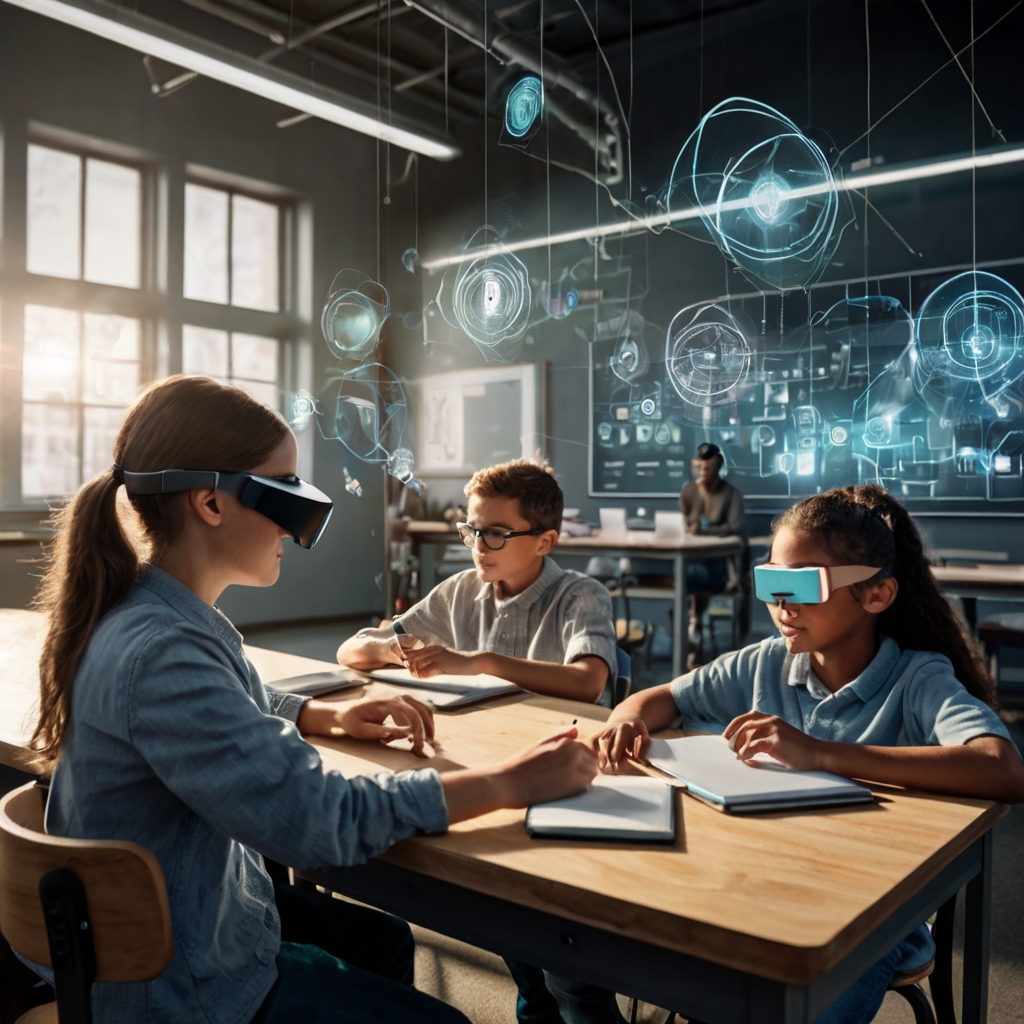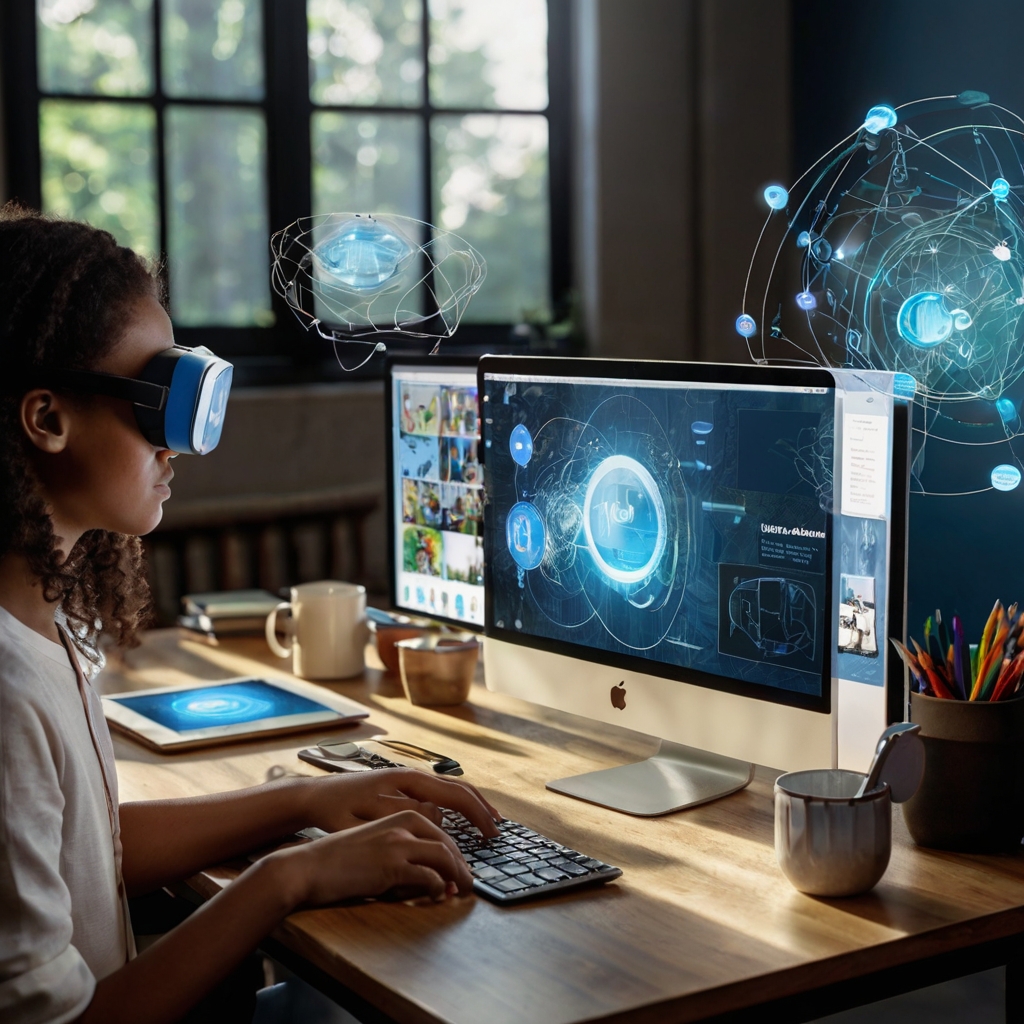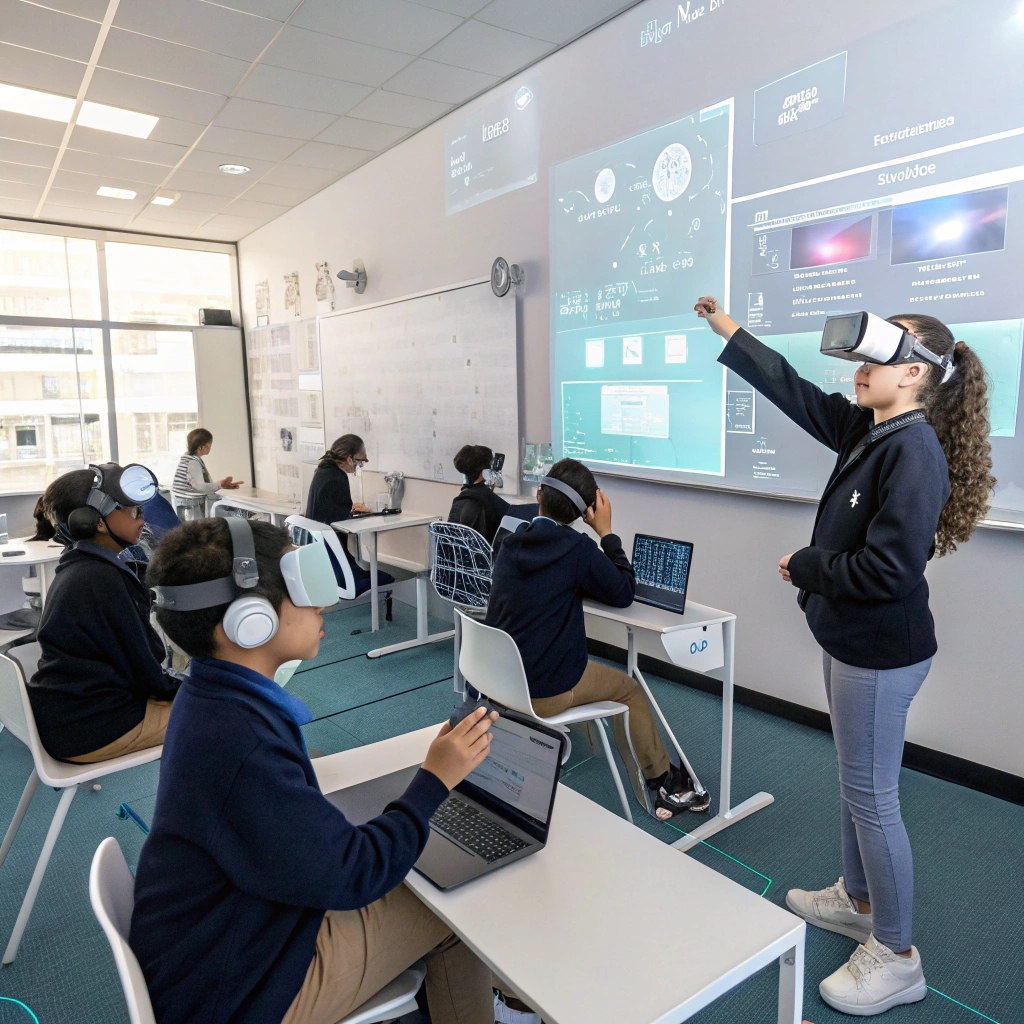In today’s digital age, where technology is rapidly changing the game, it’s easy to get left behind.
You’re no longer just learning new skills – you’re entering a virtual world that demands adaptability and quick thinking. But with this shift comes immense responsibility: ensuring students are equipped for success in an ever-evolving landscape.
What if I told you there is hope? What if future-proof digital literacy was within reach, not just some mythical concept reserved for tech elite but a skill that could be developed and mastered by anyone?
And with immersive online learning environments at our fingertips, it’s never been easier or more accessible than ever.
Discover the secret to transforming your students from novice learners into masters of their own destiny.
Gamifying Online Learning Experiences
Learning in an online environment can be a game-changer for those who take advantage of it. Gamifying your learning is one way to make this possible.
When you immerse yourself in digital experiences, anything that doesn’t work feels stale. What if the things you were supposed to learn started feeling like they’re worth earning?
Think back on how far we’ve come with levels and points already; now what if those systems could help motivate learning right out of the box?
Imagine an environment where your progress is all tracked, yet there’s always something more waiting for you just beyond that finish line. That would certainly keep things fresh and exciting.
Learning should be fun! The key to making it so is when we try to turn challenges into quests, problems into puzzles, or difficult concepts into achievements.
Creating Personalized Virtual Reality Environments for Students

In today’s digital landscape, traditional classroom methods can’t compete with the personalization and interactivity offered by virtual reality in immersive online learning settings. By creating tailored VR experiences, educators can fine-tune lessons according to individual student needs, making a significant impact on academic success. Research has shown that students using interactive simulations have improved critical thinking skills and problem-solving abilities.
For instance, consider this: traditional classroom settings may not be able to provide the same level of personalization as immersive virtual reality environments. These VR spaces allow instructors to create customized avatars for each student, which interact with other virtual objects, people or even teachers in meaningful ways that reflect their unique skills and abilities.
In one notable example, a teacher used interactive simulations to help students develop critical thinking skills through real-world scenarios that mimicked everyday situations. As a result of this innovative approach, students demonstrated improved problem-solving abilities and retention rates.
When creating personalized learning environments for future-proofed students in immersive online settings, focus on providing unique experiences tailored to individual needs and goals. This will not only increase student motivation but also lead to increased academic performance, as evidenced by research that shows interactive simulations can boost engagement and understanding.
Using these advanced features of virtual reality could help teachers teach critical thinking as well as problem-solving skills using engaging scenarios that simulate real-world situations. Moreover, studies have shown that personalized VR experiences can be an effective way to support students with special needs, reducing anxiety and promoting a more inclusive learning environment.
Using AI to Identify and Address Knowledge Gaps in Real-Time
Digital literacy has become crucial for future-proof students to succeed in immersive online environments, where vast amounts of information are accessible but often overwhelming. One key component is being able to identify knowledge gaps in real-time, a task that artificial intelligence (AI) algorithms excel at.
AI-driven adaptive learning systems can monitor progress and provide instant feedback on skill deficits, recommending targeted interventions for areas such as math concepts or language proficiency. For instance, AI can detect early warning signs of students struggling with specific skills or topics, allowing instructors to tailor their instruction to meet individual needs. This approach enables the creation of more personalized pathways for growth that help our students bridge those gaps.
By leveraging machine learning algorithms and real-time feedback, we can create adaptive learning systems that balance data security concerns with the need for instant feedback. However, implementing such systems requires careful consideration of factors like teacher buy-in and scalability.
Imagine being able to identify knowledge gaps in your students before they become entrenched problems. That’s what makes AI-driven adaptive learning so powerful! For example, a study by the National Center for Education Statistics found that personalized learning pathways led to improved student outcomes, particularly among disadvantaged groups. By using natural language processing (NLP) for chatbots or virtual assistants and adapting instructional content based on performance data, educators can create more inclusive environments.
A key challenge in implementing AI-driven adaptive learning systems is overcoming the lack of teacher buy-in and ensuring that technology is used effectively to support instruction. A 2019 study by the International Society for Technology in Education found that AI-powered assessment tools led to significant improvements in student outcomes, particularly among students with disabilities. By using evidence-based practices and providing ongoing support, educators can harness the potential of these systems to create more effective learning pathways.
Incorporating Augmented Reality into the Classroom Experience
Incorporating augmented reality (AR) into classroom experiences can take learning to the next level. Leveraging AR, teachers and educators can create engaging and interactive lessons that immerse students in real-world applications of digital skills.
Visualize complex concepts with interactive 3D models, allowing students to grasp intricate relationships between objects more easily than ever before. For instance, imagine holding a virtual globe in your hand, exploring different continents through immersive simulations that transport you to new dimensions.
Interactive AR experiences have been shown to enhance spatial reasoning by up to 30% in high school students. This is achieved through hands-on activities where students design and build models of real-world structures using augmented reality-enhanced tools.
Give your classroom the boost it needs with AR-enhanced learning experiences that make digital literacy more engaging and effective. By leveraging AR, teachers can create simulations of historical events, scientific phenomena, or even complex mathematical concepts that help students develop problem-solving skills and spatial reasoning. For example, imagine creating an AR-enhanced simulation of ancient Egypt, where students can explore mummification techniques through interactive models.
As educators begin to incorporate more digital tools into their curriculum, the potential for augmented reality becomes increasingly evident. By harnessing the power of AR, teachers can make learning more enjoyable and effective for their students, setting them up for success in an ever-changing technological landscape.
Developing Emotional Intelligence through Digital Storytelling

As we navigate the complex landscape of digital literacy, digital storytelling emerges as a game-changer for immersive online learning. Emotional intelligence is key to unlocking true mastery in today’s digital age.
By creating an online platform where kids feel comfortable sharing their stories through video or audio recordings, you can help them develop essential life skills that benefit them in the long run. Research has shown that social media platforms foster empathy and understanding among users. By providing a safe space for self-expression, you’re not only building critical thinking abilities but also encouraging active listening and perspective-taking skills.
For example, let’s say your child creates a video about their favorite animal or hobby. They can use digital storytelling as an opportunity to practice self-reflection and share their thoughts with others. This helps them develop empathy towards people who may have different opinions or experiences.
When teaching children the value of emotional intelligence in online interactions, consider using engaging examples like this: “Imagine your child is creating a video about their favorite holiday tradition.” By encouraging kids to create digital stories that showcase their unique voice and perspective, you’re helping them build essential life skills.
Building a Community of Learners through Social Learning Platforms
Social learning platforms are essential for future-proofing today’s young learners in immersive online environments. By creating an environment where everyone feels comfortable sharing their thoughts, ideas, and experiences, these platforms unlock a deeper level of engagement among students.
To take it further, social learning platforms provide the perfect space for interaction among peers, mentors, and educators who can offer support and guidance. Features like discussion forums, live chats, and video conferencing tools facilitate peer review groups that build trust within the group-making it easier to ask questions and get help from one another in real-time.
For example, a recent study found that students who participated in online discussions had higher engagement rates and better understanding of course material compared to those who didn’t. In a class where live chat facilitated peer review, students reported feeling more invested in the learning process and having fewer questions during quizzes.
Moreover, video conferencing tools enable educators to provide personalized feedback and guidance to individual students. This leads to improved academic outcomes as well as enhanced overall satisfaction among learners.
In contrast to traditional online courses that lack human interaction which can lead to a sense of disconnection from peers and instructors, social learning platforms bridge this gap by providing an immersive experience.
Encouraging Critical Thinking with Interactive Simulations
In today’s digital age, interactive simulations can be a game-changer for students. They allow learners to explore complex concepts in an immersive online environment.
To unlock digital literacy mastery, educators must design these interactions to promote active learning and engagement. By incorporating games, puzzles, or challenges into the curriculum, you’re not just teaching, you’re fostering creativity and critical thinking skills that will serve your future-proofed students well. For instance, when I was a student in an online course on data science, we worked on projects using interactive simulations to model complex systems. Not only did it help me grasp abstract concepts better, but it also reduced my anxiety about participating in class discussions which ultimately led to deeper learning and more engagement from the rest of the class.
Using simulations that mimic real-world scenarios can have a significant impact on student outcomes. For example, simulating climate change allows students to develop problem-solving skills that translate into better understanding and application of the concept leading to improved retention rates. By allowing students to experience complex systems in an interactive environment, educators can promote deeper learning and improve their ability to make informed decisions.
Another key aspect is providing feedback mechanisms that allow students to reflect on their learning and identify areas for improvement. Automated grading systems or peer review processes can help you adjust your teaching strategies based on student performance data. This kind of self-reflection helps build critical thinking skills, which are essential in today’s digital world. A study has shown that incorporating regular check-ins with instructors during an online course improves student motivation by 25%. By using interactive simulations and providing feedback mechanisms, educators can create a more immersive learning environment that fosters engagement and promotes deeper understanding.
Don’t just tell students about climate change, let them design solutions using simulated scenarios. This not only makes complex concepts more relatable but also teaches problem-solving skills and decision-making strategies that benefit their future careers. By leveraging interactive simulations in the classroom, educators can create a learning environment that is engaging, effective, and future-proof.
To get started with creating your own interactive simulations, explore tools like PhET Interactive Simulations or Simulation Studios. These resources offer a wide range of educational games and activities that you can easily integrate into your curriculum. By incorporating these tools into their teaching practice, educators can unlock the full potential of their students and help them develop the critical thinking skills they need to succeed in an increasingly digital world.
By using interactive simulations, educators can create immersive learning environments that promote deeper understanding, retention rates, and improved student outcomes ultimately leading to a more effective use of technology in education.
Using Big Data to Personalize Learning Experiences

Tailoring instruction to individual needs is key to unlocking academic success in immersive online environments. Big data can help identify areas where students need extra support or enrichment, enabling teachers to provide targeted guidance.
By analyzing student performance data, we can uncover patterns and trends that inform instruction and optimize the learning experience. This approach allows educators to tailor their teaching methods to meet each student’s unique needs, leading to better outcomes and a deeper understanding of complex concepts.
Personalized feedback is just one way technology helps teachers tailor their teaching. For instance, our school uses data on course completion rates to identify areas where students are struggling and provide targeted support. This approach has helped students like Emily, who was previously falling behind in math but excelled after receiving tailored feedback from her teacher. By analyzing vast amounts of student performance data, we can create highly individualized lessons that cater to different learning styles and abilities.
However, using big data analytics also raises important questions about bias, equity, and fairness. For example, if a school uses standardized tests to inform instruction but neglects the needs of English language learners or students from low-income backgrounds, it may exacerbate existing inequalities. To address this concern, educators can use machine learning algorithms that account for these factors and provide more nuanced insights.
Big data analytics can also help identify areas where students need extra support or enrichment. By providing teachers with actionable data-driven recommendations, we can ensure that every student receives the instruction they need to succeed. This approach has been shown to improve student outcomes, particularly for historically marginalized groups who may have previously been overlooked by traditional teaching methods.
For instance, a school in Chicago used machine learning algorithms to identify students who were at risk of dropping out. By providing targeted support and interventions, the school was able to reduce dropout rates by 25%. Similarly, teachers can use data on student performance to create customized learning plans that cater to individual needs and abilities.
By leveraging big data analytics and personalized feedback systems, educators can provide a more equitable and effective learning experience for all students. This approach requires ongoing evaluation and refinement to ensure that it meets the diverse needs of students from different backgrounds, but its potential benefits are significant.
Designing Inclusive and Accessible Virtual Classrooms for All Students
When designing virtual classrooms, consider how different student needs can impact the learning experience. This involves creating an environment that caters to diverse preferences.
Creating inclusive design is key when crafting online teaching spaces. Accessibility features like captioning for audio materials and closed captions for videos with audio descriptions enable students of all abilities to fully participate in class discussions and access course content seamlessly. For example, incorporating alt-text for images helps visually impaired learners understand complex concepts by providing a verbal description of each image.
Incorporating clear headings on slides reduces cognitive load and facilitates comprehension for students with learning disabilities or visual impairments. This design choice can also serve as an excellent starting point to discuss the benefits of inclusive design beyond accessibility, such as fostering a sense of community among learners. By creating welcoming spaces that feel accessible, even introverted students are more likely to contribute in discussions without feeling self-conscious about being “on display.” This helps build trust and encourages collaboration, essential components for developing digital literacy skills.
Feedback mechanisms play a pivotal role in inclusive design by enabling students to voice their needs and preferences. Surveys, forums, or direct communication with instructors allow learners to share insights on how they can better learn within the virtual classroom environment. By gathering feedback throughout the design process, educators can refine the learning experience to accommodate each student’s unique requirements.
For instance, a school implemented an accessible online platform that allowed students who were deaf or hard-of-hearing to fully engage in discussions using video conferencing with real-time captioning and transcriptions of lectures. The result was increased participation among previously marginalized learners, ultimately improving their academic outcomes. By fostering inclusive design through continuous feedback loops, educators can ensure every learner has an opportunity to succeed.
Designing Inclusive and Accessible Virtual Classrooms for All Students is an art that balances the needs of diverse students with varied abilities within a virtual setting, allowing each student to reach their full potential.
Revolutionize Learning: Unlocking Digital Literacy Mastery for Future-Proof Students in Immersive Online Environments
Overcoming Technical Issues in Online Education Systems
Great educators won’t tolerate outdated technology holding them back. The moment technical issues plague your online learning systems, students get frustrated and their educational experience suffers.
And those technical problems are likely to compound when you fail to address them promptly.
Technical glitches can lead to lost instruction, missed deadlines, and even abandonment of the course altogether – resulting in a wasted investment for both instructors and institutions.
So, take control now by investing in robust digital infrastructure that safeguards your online learning environment from technical issues. Your students will thank you.
Take decisive action today to safeguard future-proof learning experiences that foster growth and success – start tackling those technical challenges head-on!
